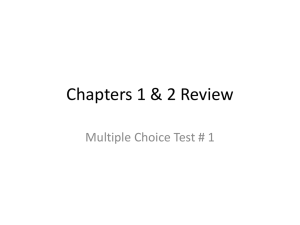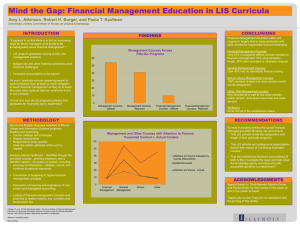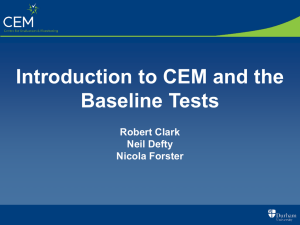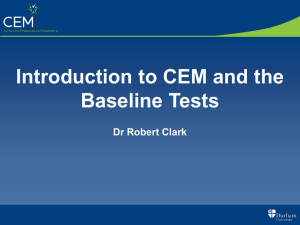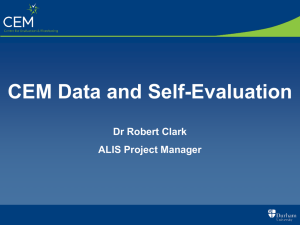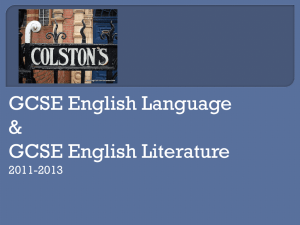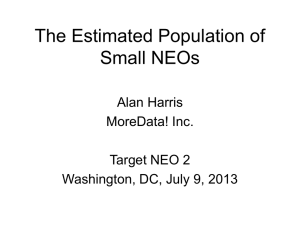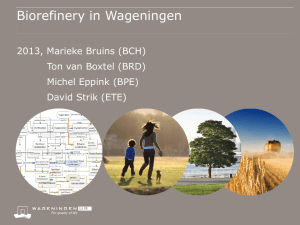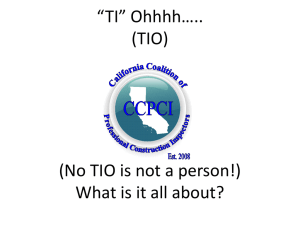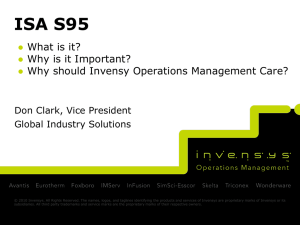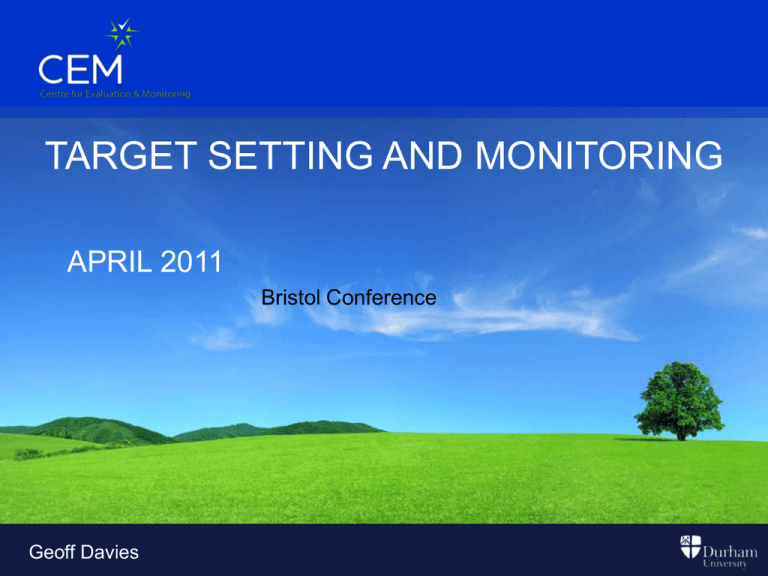
TARGET SETTING AND MONITORING
APRIL 2011
Bristol Conference
Geoff Davies
How can the CEM help target
setting and monitoring?
Questions
– What is our students’ potential and are they
fulfilling it?
– How does our School/College compare to
similar institutions?
– What are appropriate targets for our
School/College?
– Who plays the tune!!
– How do we monitor within a supportive
culture?
TOXINS
NUTRIENTS
Ideas being rejected or stolen
Constant Carping Criticisms
Being Ignored
Being Judged
Being Over Directed
Not being listened to
Being misunderstood
Being valued
Being Encouraged
Being Noticed
Being Trusted
Being listened to
Being Respected
Our experience is that the CEM centre systems
provide NUTRIENTS
It is a highly respected Independent Research Base
The largest provider of performance indicators in
the world
NO political agenda
THIS CEM stuff IS
THE BEST THING
SINCE SLICED
BREAD!
HEADTEACHER
A RIGHT TO BE
SUSPICIOUS!
A PLEA
DON’T LET THERE BE A LONE RANGER!
ALL need to be involved in the process
Having one ‘expert’ is unhealthy and can be dangerous
Most teachers know their students’ strengths
and weaknesses. Professional judgement is
still of the utmost importance but there are surprises.
Using data as a tool to help improve your student’s
achievement cannot be a one-person job.
The processes of discussion about students between
teachers based on an objective data source have proved to be
important in improving outcomes.
Necessary knowledge base to use CEM systems to their potential
1.
•
•
•
•
•
The forms of Value Added Data:
scatter graphs
raw and standardised residuals
SPC charts
tables of data
use of PARIS for further analyses (e.g. by gender, teaching group)
2.
•
•
•
Predictive Data:
point and grade predictions
importance of chances graphs
availability of different predictive data
3. Baseline Data
• band profile graphs
• IPRs
• Average GCSE score
• Computer adaptive tests
If you have the tools you can use them to do these
• Make curriculum changes
• Adjust staffing structure and cater for student needs
• self-evaluation procedures including the analysis of examination results
using value added data
• the target setting process
• school and department development plans…….
• Improve your monitoring procedures
THE TARGET SETTING PROCESS
You know what Research Tells Us
• Goals must be specific
• Goals must be challenging
• Need for goal commitment
• Need for feedback
Research Does Not Say
•
•
•
•
Who should set the targets.
Possible levels of achievement!
If it works in education
If it can be made to work in very complex tasks.
What are the targets for?
Are you aiming the targets!
OR
Do the targets belong to and are being aimed at by all?
THE MOST IMPORTANT WORD IN
EDUCATION???
CULTURE
TARGET SETTING
‘Intelligent’ Target Setting involves:
• Using reliable predictive data and chances graphs
• Dialogue between the users: teachers, parents and
students? (empowering, ownership, and taking
responsibility)
• The use of professional judgement……..
Setting Targets: why?
•
•
•
•
•
A process between student and staff of
setting a challenging and realistic goal
The subsequent monitoring of student
progress
Incorporating target data into department
self evaluation
And NEVER because it has to be done!
And NEVER to use aspirational targets for
accountability.
There is wide-ranging practice using CEM data to set student,
department and institution targets.
Increasingly sophisticated methods are used by schools and colleges.
The simplest model is to use the student grade predictions. These
then become the targets against which student progress and
achievement can be monitored.
Theoretically, if these targets were to be met, residuals would be zero so
overall progress would be average.
The school/college would be at the 50th percentile.
More challenging targets would be those based on the basis of history.
For example. Where is the school/college now? Where is your subject
now?
If your subject value added history shows that performance is in the
upper quartile it may be sensible to adjust targets. This may have the
effect of raising point predictions between 0.2-0.5 of a grade.
This would be a useful starting point, but it would not be advisable to use
the predictions for below average subjects, which might lead to
continuing under achievement.
However, these examples do not necessarily give ownership of the data to
staff or students, so may not be effective in practice. Involving teachers as
part of the process should encourage more responsibility to achieve the
targets.
For example, staff receive the statistically generated targets. Using these as a
starting point, they could adjust using their professional judgement and
knowledge of the students. This process may have to be monitored initially.
Targets are purely established as part of the internal monitoring system and do
not become part of the value added data.
The targets set in this way only become aspirational for the student if
they are involved in the process
Involving students should result in the student taking more responsibility
for their learning.. This would give ownership of the adjusted predictions to
the department. The subject teachers could then discuss these predictions
with the students to finalise the target grade . Referring to this part of the
discussion could be a powerful motivator to encourage the student, as well
as reminding them what could happen if they do not work/take
responsibility.
Students are not robots who will always fit with statistics so it is
dangerous to make sweeping statements based on one set of results.
A suggested pincer attack
CULTURE IS EVERYTHING
IT’S NOT WHAT YOU DO BUT THE WAY THAT YOU DO IT
•
ASPIRATIONAL TARGETS FOR STUDENTS
(VERY HIGH EXPECTATIONS IN NEGOTIATION WITH SUBJECT TEACHERS)
MINIMUM ACCEPTABLE GRADES CULTURE FOR ALL WORK
•
HISTORIC DATA INFORMING DEPARTMENTAL TARGETS (See next slide)
•
CLASS TARGETS SET BY TEACHER/MENTOR USING DATA AND PROFESSIONAL
JUDGEMENT
•
HEAD’S/PRINCIPAL’S TARGETS (INFORMED FROM ABOVE BUT NOT SIMPLY
AGGREGATED)
•
PUBLISHED TARGETS (INFORMED FROM ABOVE BUT NOT SIMPLY AGGREGATED)
•
OTHER EXTERNAL TARGETS (AN ENGLISH DISEASE THAT NEEDS TREATMENT!)
Setting departmental targets:
one suggested approach
• Discuss previous value added data with each HoD
• Start with an agreed REALISTIC representative figure
based previous years (3 ideally) of value added data
• add to each pupil prediction, and convert to grade (i.e. inbuilt value added)
• By discussion between teachers and students and using
professional judgement, AND THE CHANCES GRAPHS,
adjust target grade
• calculate the department’s target grades from the addition
of individual pupil’s targets
Whatever you do respect the professional judgement of the vast majority of teachers
Paris97.xls
S u b je c t
A rt & D e s ig n
B u s in e s s S tu d ie s
D e s ig n & T e c h n o lo g y
D ra m a
E n g lis h
E n g lis h L ite ra tu re
F re n c h
G e o g ra p h y
G e rm a n
H is to ry
H o m e E c o n o m ic s
IC T
M a th s
M u s ic
P h ys ic a l E d u c a tio n
R e lig io u s S tu d ie s
D o u b le S c ie n c e
W e ls h
P e rc e n ta g e
P e rc e n ta g e
N um ber of
o f A* to C
o f A* to G
Av e ra g e
S tu d e n ts
G ra d e s
G ra d e s
G ra d e
68
64
103
27
181
15
53
84
7
49
48
71
180
12
72
37
180
177
84
48
63
85
64
60
64
63
71
67
48
68
54
67
65
70
52
72
100
100
100
100
100
100
100
100
100
100
100
100
100
100
100
100
100
100
S c h o o l A ve ra g e G C S E s c o re :
5 .2
4 .3
4 .7
5 .3
4 .8
4 .6
4 .9
4 .8
5 .1
5 .1
4 .5
4 .9
4 .5
5 .2
4 .9
5 .2
4 .4
5 .1
(C )
(C /D )
(C /D )
(B /C )
(C )
(C /D )
(C )
(C )
(C )
(C )
(C /D )
(C )
(C /D )
(C )
(C )
(C )
(C /D )
(C )
4 .7 (C /D )
C o u n te d P e rfo rm a n c e S ta tis tic s (B a s e d o n S u b je c t C h o ic e P re d ic tio n s )
5 o r m o re A * to C G ra d e s :
106
1 o r m o re A * to C G ra d e s :
141
5 o r m o re A * to G G ra d e s :
181
1 o r m o re A * to G G ra d e s :
181
58%
77%
99%
99%
5 o r m o re A * to C G ra d e s in c M a th s a n d E n g lis h :
2 o r m o re A * to C G ra d e s - S c ie n c e s :
1 o r m o re A * to C G ra d e s - M o d e rn F o re ig n L a n g u a g e :
54%
51%
20%
98
93
36
T h e u n d e rlyin g p re d ic tio n s s u m m a ris e d h e re a re b a s e d o n e x p e c ta tio n s fo r a n a ve ra g e s c h o o l a c h ie vin g
ze ro va lu e a d d e d re s u lts . A p p ro p ria te c a re s h o u ld b e ta k e n in in te rp re tin g th e m w ith in yo u r s c h o o l.
P le a s e n o te th a t th e c u t-o ff p o in ts fo r g ra d e C a n d g ra d e G h a ve b e e n s e t a t 4 .5 a n d 0 .5 re s p e c tive ly.
D u e to th e s e n s itive n a tu re o f th e c u t o ff p o in ts , p re d ic tio n s m a y va ry fo r yo u r s c h o o l if th e c u t o ff p o in ts
c o u ld b e a lte re d .
(*P re d ic tio n s A d ju s te d fo r P o s itive P rio r V a lu e -a d d e d P e rfo rm a n c e )
S u b je c t
A rt & D e s ig n
B u s in e s s S tu d ie s
D e s ig n & T e c h n o lo g y
D ra m a
E n g lis h
E n g lis h L ite ra tu re
F re n c h
G e o g ra p h y
G e rm a n
H is to ry
H o m e E c o n o m ic s
IC T
M a th s
M u s ic
P h ys ic a l E d u c a tio n
R e lig io u s S tu d ie s
D o u b le S c ie n c e
W e ls h
P e rc e n ta g e
P e rc e n ta g e
N um ber of
o f A* to C
o f A* to G
Av e ra g e
S tu d e n ts
G ra d e s
G ra d e s
G ra d e
68
64
103
27
181
15
53
84
7
49
48
71
180
12
72
37
180
177
84
48
87
100
69
67
96
73
86
67
79
96
57
92
65
70
59
86
100
100
100
100
100
100
100
100
100
100
100
100
100
100
100
100
100
100
S c h o o l A ve ra g e G C S E s c o re :
5 .2
4 .3
5 .3
6 .0
4 .9
4 .9
6 .4
5 .2
5 .6
5 .1
5 .2
5 .7
4 .6
5 .7
4 .9
5 .3
4 .7
5 .5
(C )
(C /D )
(B /C )*
(B )*
(C )*
(C )*
(A /B )*
(C )*
(B /C )*
(C )
(C )*
(B /C )*
(C /D )*
(B /C )*
(C )
(B /C )*
(C /D )*
(B /C )*
5 .1 (C )
C o u n te d P e rfo rm a n c e S ta tis tic s (B a s e d o n S u b je c t C h o ic e P re d ic tio n s )
5 o r m o re A * to C G ra d e s :
125
1 o r m o re A * to C G ra d e s :
162
5 o r m o re A * to G G ra d e s :
181
1 o r m o re A * to G G ra d e s :
181
69%
89%
99%
99%
5 o r m o re A * to C G ra d e s in c M a th s a n d E n g lis h :
2 o r m o re A * to C G ra d e s - S c ie n c e s :
1 o r m o re A * to C G ra d e s - M o d e rn F o re ig n L a n g u a g e :
56% *
58% *
30% *
102
106
54
*
*
*
*
(*P re d ic tio n s A d ju s te d fo r 7 5 th P e rc e n tile )
S u b je c t
A rt & D e s ig n
B u s in e s s S tu d ie s
D e s ig n & T e c h n o lo g y
D ra m a
E n g lis h
E n g lis h L ite ra tu re
F re n c h
G e o g ra p h y
G e rm a n
H is to ry
H o m e E c o n o m ic s
IC T
M a th s
M u s ic
P h ys ic a l E d u c a tio n
R e lig io u s S tu d ie s
D o u b le S c ie n c e
W e ls h
P e rc e n ta g e
P e rc e n ta g e
N um ber of
o f A* to C
o f A* to G
Av e ra g e
S tu d e n ts
G ra d e s
G ra d e s
G ra d e
68
64
103
27
181
15
53
84
7
49
48
71
180
12
72
37
180
177
97
63
73
96
70
67
74
70
71
84
63
77
61
83
72
81
59
82
100
100
100
100
100
100
100
100
100
100
100
100
100
100
100
100
100
100
S c h o o l A ve ra g e G C S E s c o re :
5 .5
4 .6
5 .0
5 .5
5 .0
4 .9
5 .1
5 .1
5 .4
5 .4
4 .8
5 .2
4 .8
5 .5
5 .2
5 .5
4 .7
5 .4
(B /C )*
(C /D )*
(C )*
(B /C )*
(C )*
(C )*
(C )*
(C )*
(B /C )*
(B /C )*
(C )*
(C )*
(C )*
(B /C )*
(C )*
(B /C )*
(C /D )*
(B /C )*
5 .0 (C )
C o u n te d P e rfo rm a n c e S ta tis tic s (B a s e d o n S u b je c t C h o ic e P re d ic tio n s )
5 o r m o re A * to C G ra d e s :
123
1 o r m o re A * to C G ra d e s :
162
5 o r m o re A * to G G ra d e s :
181
1 o r m o re A * to G G ra d e s :
181
68%
89%
99%
99%
5 o r m o re A * to C G ra d e s in c M a th s a n d E n g lis h :
2 o r m o re A * to C G ra d e s - S c ie n c e s :
1 o r m o re A * to C G ra d e s - M o d e rn F o re ig n L a n g u a g e :
60% *
58% *
23% *
109
106
41
*
*
*
*
Summary
Successful target setting should be a
simple and transparent process.
The outcomes of this process would
support the monitoring of student progress
over the duration of the course and
provide a realistic but challenging goal that
students can take responsibility for to
achieve their potential
MONITORING PUPIL PROGRESS
• You need monitoring and tracking procedures
appropriate to your culture
• based on the agreed targets
• reporting to parents/guardians
• and linked to appropriate intervention, support
and so on
Monitoring students’ work against target grades is established practice in
schools and colleges, and there are many diverse monitoring systems in
place.
Simple monitoring systems can be very effective
Current student achievement compared to the target grade done at
predetermined regular intervals to coincide with, for example internal
assessments/examinations
Designated staff having an overview of each student’s achievements across
subjects
All parents being informed of progress compared to targets
Review of progress between parents and staff
Subject progress being monitored by a member of the management team in
conjunction with the head of subject/department
A tracking system to show progress over time for subjects and students
J
M
9 7 .3
101 A
M ID Y IS
C
F
7 1 .8
99 B
132 131 127 105
ON ENTRY
94
5
4
5
-2 .2 6
5
6
6
-2 .5 5
6
6
5
-3
101
86
6
4
5
-0 .1 5
4
3
4
-2 5
5
5
4
-1 .8
83 116
KEY STAGE 3 STATUTORY TEACHER ASSESSMENT
94
Pupil Tracking
92 113
S O S C A S T A N D A R D IS E D S C O R E S
98
96
83 102
98
90 103
87
97
95
98
83
95
88
S O S C A M a th s
S O S C A S t.S c o re S P A C E .M a th s
S O S C A S t.S c o re N U M B E R M a th s
S O S C A S t.S c o re H .D A T A M a th s
S O S C A S t. S c o re P h y s ic s
S O S C A S t. S c o re C h e m is try
S O S C A S t. S c o re B io lo g y
S O S C A (S T A .) R e a d in g
S t. re s . M ID Y IS - K S 3 S c
S C T A S c ie n c e S u b je c t W a
P E T A P h y s E d S u b je c t W a
M U T A M u s ic S u b je c t W a
M F T A M F L S u b je c t W a
S t. re s . M ID Y IS - K S 3 M a
M A T A M a th s S u b je c t W a
IC T A In f T e c h S u b W a
H I T A H is to ry S u b je c t W a
G E T A G e o g ra p h y S u b W a
S t. re s . M ID Y IS - K S 3 E n
E N T A E n g lis h S u b je c t W a
D A TA D es and Tech Sub W a
A R T A A rt S u b je c t W a
M id Y IS S k ills S ta n d a rd is e
M id Y IS N o n V e rb a l S ta n d a r
M id Y IS V o c a b u la ry S ta n d a r
M id Y IS M a th s S ta n d a rd is e d
M id Y IS O v e ra ll S ta n d a rd is
M id Y IS O v e ra ll B a n d Y e a r
L O N D O N R E A D IN G
% A tte n d a n c e Y 1 0
G ender
S u rn a m e F o re n a m e
Tracking at departmental level for one student
S tu d e n t: P e te r H e n d ry
D e p a rtm e n t: G e o lo g y
te s t e s s a y:
te s t: G e o l
ra d io m e tric
T im e S c a le
d a tin g
1 5 /0 9 /2 0 0 6
2 2 /0 9 /2 0 0 6
2 0 0 6 -8
te s t:
te s t: d a tin g
h o m e w o rk
p ra c t: ro c k
ig n e o u s
ro c k c yc le
te x tu re s
ro c k s
ta rg e t
g ra d e
97%
A
2 1 /1 1 /2 0 0 6
84%
68%
B
C
0 6 /1 0 /2 0 0 6 2 0 /1 0 /2 0 0 6 0 6 /1 1 /2 0 0 6
57%
54%
D
E
U
50%
SURNAME
B rig g s
F le tc h e r
G re e n
H a va rd
e tc
p u n c tu a lity
m e e tin g d e a d lin e s
D
B
A
A
1
2
1
3
2
2
1
3
1
2
2
4
C
B
B
B
1
2
2
4
1
1
2
2
1
1
2
2
m e e tin g d e a d lin e s
p u n c tu a lity
DEC
e ffo rt
OCT
c u rre n t le v e l
e ffo rt
C
B
B
A
c u rre n t le v e l
C
A
C
A
m e e tin g d e a d lin e s
A lic e
K e vin
F e lic ity
M ic h a e l
p u n c tu a lity
yr 1 2
e ffo rt
B IO L O G Y
c u rre n t le v e l
FORENAM E
n e g o c ia te d ta rg e t
g ra d e
s u b je c t:
in itia l ta rg e t g ra d e
Traditional mark book approach
0 7 -0 8
MAR
N am e
0 .5 9 9 3 8
-7 .0 7 0 1 3
80
33
4 1 .1 2 0 0 1
4 9 .3 4 4 0 2
3 2 .8 9 6 0 1
B
96
95
119
111
84
67
88
118
91
120
108
115
87
117
105
98
69
69
115
118
109
123
89
115
76
90
97
63
5 0 .1 7 0 6 5 6 0 .2 0 4 7 8
4 9 .8 7 0 9 6 5 9 .8 4 5 1 5
6 4 .1 3 6 2 7 6 .9 6 3 4 4
5 9 .4 6 1 0 4 7 1 .3 5 3 2 4
4 3 .3 3 7 7 2 5 2 .0 0 5 2 6
3 3 .0 2 8 3 8 3 9 .6 3 4 0 6
4 5 .8 5 5110
1 0 5 5 .0 2 6 1 4
6 3 .8 3 6 5 1 7 6 .6 0 3 8 1
4 7 .4 7 3 49
4 0 5 6 .9 6 8 1 3
6 4 .7 9 5 5 2 7 7 .7 5 4 6 2
5 7 .6 0 2 98
6 0 6 9 .1 2 3 5 5
6 2 .0 9 8 3 1 7 4 .5 1 7 9 7
4 5 .3 1 5 67
7 0 5 4 .3 7 8 8 1
6 2 .9 9 7 3 8 7 5 .5 9 6 8 5
5 5 .8 0 4 86
2 0 6 6 .9 6 5 7 8
5 1 .5 4 9 2 2 6 1 .8 5 9 0 7
3 4 .4 6 65
9 0 4 1 .3 6 0 2 8
3 4 .1 0 7 2 7 4 0 .9 2 8 7 2
6 1 .9 1 8 44
9 0 7 4 .3 0 2 1 9
6 3 .7 1 6 6 3 7 6 .4 5 9 9 6
5 8 .3 2 2 23
2 0 6 9 .9 8 6 6 6
6 6 .4 7 3 7 8 7 9 .7 6 8 5 4
4 6 .0 3 4 92
3 0 5 5 .2 4 1 9 1
6 1 .5 5 8 8 7 7 3 .8 7 0 6 4
3 8 .4 8 2 71
4 0 4 6 .1 7 9 2 9
4 6 .5 7 4 3 7 5 5 .8 8 9 2 4
5 0 .8 8 9 9 6 1 .0 6 7 8 9
0
-7 .0 7 0 1 3 -8 .4 8 4 1 5 6
6 .4
0 84156
-7 .0 7 0 1 3 -8
-7 .0 7 0 1 3 -8 .4 8 4 1 5 6
-7 .0 7 0 1 3 -8 .4 8 4 1 5 6
-7 .0 7 0 1 3 -8 .4 8 4 1 5 6
-7 .0 7 0 1 3 -8 .4 8 4 1 5 6
4 0 .1 3 6 5 2
3 9 .8 9 6 7 7
5 1 .3 0 8 9 6
4 7 .5 6 8 8 3
3 4 .6 7 0 1 7
2 6 .4 2 2 7 1
3 6 .6 8 4 0 9
5 1 .0 6 9 2 1
3 7 .9 7 8 7 5
5 1 .8 3 6 4 1
4 6 .0 8 2 3 7
4 9 .6 7 8 6 5
3 6 .2 5 2 5 4
5 0 .3 9 7 9
4 4 .6 4 3 8 6
4 1 .2 3 9 3 8
2 7 .5 7 3 5 2
2 7 .2 8 5 8 1
4 9 .5 3 4 8
5 0 .9 7 3 3 1
4 6 .6 5 7 7 7
5 3 .1 7 9 0 3
3 6 .8 2 7 9 4
4 9 .2 4 7 0 9
3 0 .7 8 6 1 9
3 7 .2 5 9 5
4 0 .7 1 1 9 2
-5 .6 5 6 1 0 4
0 56104
-57.6
-5 .6 5 6 1 0 4
-5 .6 5 6 1 0 4
-5 .6 5 6 1 0 4
-5 .6 5 6 1 0 4
D
E
F
g
h
I
J
K
L
M
N
O
P
Q
R
S
T
U
V
W
X
Y
Z
ZA
ZB
80
80
73
45
45
63
50
60
50
35
35
58
83
45
73
5
30
70
50
45
60
30
65
10
55
70
T e s t S c o re
A
C
OTHER
IDEAS
M id Y is S c o re T e s t S c o re
A s tro n o m y 7 N
M id Y is T e s t R e vie w
80
90
100
M id Y is S c o re
110
120
130
MONITORING YOUR SCHOOL OVER TIME
INFORMS SELF EVALUATION
SELF EVALUATION DRIVES DEVELOPMENT PLANNING
Alis Value-Added
MONITORING MIDYIS YEAR 7 TO SOSCA MATHS SCORE YEAR 9
Sex
MidYIS
Test
Score
Predicted
SOSCA
Score
Actual
SOSCA
Score
Raw
Residual
Standardised
Residual
A
F
99
93
96
3
0.4
B
F
105
97
97
-1
-0.1
C
M
102
95
86
-10
-1.1
D
F
72
73
73
1
0.1
E
F
152
134
121
-13
-1.5
Surname
Forename
On-line attitudinal surveys
• MidYIS, SOSCA, INSIGHT Yellis and Alis
• Developed to meet new needs
• Can be more easily adapted to meet new
developments
• The Parental Questionnaire
• The Event mapper
Evidence from Pupils (Alis)
Extended Comparison Graphs
The following list gives the titles of Comparison Graphs
currently provided by the Extended Yellis questionnaire:
•Alienation Indicators
•Attitudes to Design & Technology
•Attitudes to English
•Attitudes to a Foreign Language
•Attitudes to Mathematics
•Attitudes to Science
•Career-Relevant Activities Experienced
•Sources of Careers Information Found Useful
•Preferences for Kinds of Work
•Items in the Freedom from Free Scale
•Design and Technology Homework
•English Homework
•Foreign Language Homework
•Mathematics Homework
•Science Homework
•Career Choice Motivators
•Parental Involvement: Mothers
Your data is above the Yellis average
•Parental Involvement: Fathers
Your data is below the Yellis average
•Influences on Staying-On
•Traumatic Events Experienced by Pupils
Your data is about the same as the Yellis average
•Places Where Pupils Feel Unsafe
•Work Place Preferences
Your data is about the same as the Yellis average
•Cigarettes, Alcohol and Drugs
SUMMARY
1. SUMMATIVE VALUEADDED
MONITORING
AT THE END OF THE COURSE
2. FORMATIVE VALUE ADDED
MONITORING
DURING THE COURSE
3. FORMATIVELY WITH STUDENTS
TO SET TARGET GRADES
‘When working with individual students the predictions themselves
are of lesser importance than the formative process of working with
students to motivate them to focus on raising achievement.’
PROXIMAL FACTORS WORK BEST Prof Peter Tymms
SOME TRAPS TO AVOID
Marksheet Name : SUBJECT REVIEW
Marksheet Group : 11S1
A
B
GCSE Standard Residual Ma
WJEC/GCSE 018403 ResGF
WJEC/GCSE 018402 ResGF
WJEC/GCSE 018401 ResGF
YELLIS GCSE PREDICTION MA
a
90019
6
b
90090
7
c
90045
6
63 A
B
B
B
B
0.10
d
90063
7
64 A
A
B
B
B
0.10
e
90166
6
48 B
B
B
C
C
0.40
f
90123
7
70 A
A
A
A
B
-0.40
g
90129
6
47 C
C
B
C
C
0.50
h
90146
6
59 B
B
A
B
A
1.40
I
90047
7
62 A
A
B
B
B
0.20
j
90115
7
67 A
A
*
A
A*
1.70
k
90004
6
46 C
B
B
C
B
1.50
l
90164
7
65 A
A
A
B
A*
1.90
m
90099
7
70 A
A
A
A
A*
1.50
n
90011
7
61 A
A
A
B
A
1.30
o
90112
7
66 A
A
B
A
A
0.80
p
90058
6
70 A
A
B
A
A
0.50
q
90150
7
72 A
A
A
A
A
0.40
r
90127
6
52 B
B
B
C
B
1.00
s
90030
6
58 B
B
B
B
B
0.50
t
90050
7
71 A
A
A
A
A
0.40
u
90016
6
69 A
A
B
A
B
-0.40
v
90174
7
74 A
A
A
A
A
0.20
w
91165
6
62 A
B
B
B
x
90109
7
63 A
B
B
B
B
0.10
y
90138
7
47 C
B
B
C
B
1.40
z
90122
7
60 A
A
*
B
A
1.30
ab
90009
7
60 A
A
A
B
A
1.30
ac
90169
7
79 A
A
*
A*
A
-0.20
ad
90153
6
56 B
B
B
B
ae
90010
7
64 A
B
B
B
A
1.00
af
90154
7
61 A
C
B
B
B
0.30
Total
62 A
PREDICTION MATHS
YELLIS MATHS BAND
Yellis Band
Yellis Score
Admission No.
Students
CLASS
REVIEW
: 04/10/2005
Maths Test K3 Wa
Export Date
B
A
B
1.20
B
B
0.20
B
0.70
1323
1868
109
105
201
156
12
190
31
30
30
30
31
30
2
29
30
Mean
42.68
62.27
3.63
3.5
6.48
5.2
6
6.55
0.70
Mean Grade
6.00
Num ber of Results
B
B
B
B
B
B
20.90
BEWARE
PITFALLS
INTERPRETATION
SUBJECT M
Sex
M
M
F
M
F
F
M
M
F
F
F
M
Score
(Band)
53 (B)
38 (C)
36 (D)
48 (C)
52 (B)
65 (A)
70 (A)
38 (C)
40 (C)
70 (A)
44 (C)
56 (B)
Predicted Grade
5.4 (B/C)
4.5 (C/D)
4.4 (C/D)
5.1 (C)
5.3 (B/C)
6.1 (B)
6.4 (A/B)
4.5 (C/D)
4.6 (C/D)
6.4 (A/B)
4.8 (C)
5.6 (B/C)
5.3 (B/C)
Achieved Grade
6 (B)
3 (E)
3 (E)
5 (C)
6 (B)
7 (A)
3 (E)
4 (D)
5 (C)
7 (A)
6 (B)
5 (C)
5.0 (C)
Raw
Residual
0.6
-1.5
-1.4
-0.1
0.7
0.9
-3.4
-0.5
0.4
0.6
1.2
-0.6
-0.3
Standard
ised
Residual
0.5
-1.1
-1.0
-0.1
0.5
0.7
-2.5
-0.4
0.3
0.4
0.9
-0.4
-0.2
REVISED
0.5
-1.1
-1.0
-0.1
0.5
0.7
-0.4
0.3
0.4
0.9
-0.4
0.0
RESPECT HIGH EXPECTATIONS FROM TEACHERS
BUT DON’T USE ASPIRATIONAL TARGETS SET FOR PSYCHOLOGICAL
REASONS TO MOTIVATE STUDENTS FOR THE ACCOUNTABILITY OF
TEACHERS
OTHERWISE THEIR EXPECTATIONS MAY NOT BE AS HIGH NEXT TIME
TARGET SETTING AND
MONITORING
BRISTOL CONFERENCE APRIL
2011
Acknowledgments are made to numerous colleagues across the
UK who have shared their experiences of using CEM centre
systems.
Particularly thanks to Professor Peter Tymms, Peter Hendry, CEM
centre staff and Dyffryn Taf School

